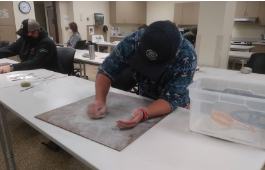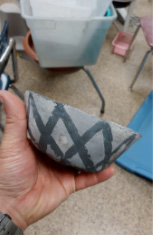

Students on the campus of the University of Minnesota Crookston are actively engaged in hands-on learning throughout the year. Eric Castle, associate professor in the Agriculture and Natural Resources department, has taken it to heart as he sought to show students in his Art 1353: Pottery Design and Techniques course they can make pottery from materials found in nature.
Castle learned the ancient technique of the Anasazis, a Native American people that inhabited the American southwest in modern day Colorado, Arizona, Utah, and New Mexico, during a class he had taken this summer.
“One of the teachers I learned this from was contracted by the Bureau of Land Management, the federal agency that manages a lot of land out west,” Castle stated. “They paid him to go around the southwestern United States and assess clay deposits for their use of making pottery. He has been doing pottery since the 1970s. He has been trying to replicate ancient techniques. He was a good person to go out and assess clay sources and he found a bunch of them that were suitable in making pottery-style clay.”

Castle brought back his teacher’s favorite clay and it became the root of one of the class projects this semester. The process was an elaborate one as Castle taught his students how to utilize materials around them.
“We brought the clay back (to Crookston) in a bucket with chunks of this lightish-gray colored clay,” Castle said. “From there we needed to process it. We then processed the clay by going out in the nature nook and finding a good round rock from the landscaped areas. We used that to grind up the clay and turned it into a fine powder. If there were any rocks in the clay we cleaned them out at the same time. Then we got it wet and mixed it to the right consistency for working. We had to add a little bit of sand to add structural support. From there, we made coil pots and let those dry.”
After the pots were dry Castle and his class focused on painting the pots using a technique known as black and white style. “There is a lot of evidence of white-looking pottery and the paint is black. To get that black color of the paint, the paint we used was made from Rocky Mountain Bee Plant. You take the whole plant and you put it in a pot and mash it and heat it up for a couple of days. It boils down to a tarry consistency. From there we made paint brushes using Yucca leaves. You have the stiff part of the leaf and the other part we used our favorite rocks to mash the end of the Yucca leaves and scrape off the pulpy flesh so we were left with just the fibers of the Yucca leaves. We then painted the pots.”
After the pots were painted the focus became firing the clay to finalize the project. In order to stick with the ancient techniques of the Anasazi people, Castle needed to find sandstone and an area in which the class could dig a hole for an underground kiln. It was with the help of the Facilities staff at UMN Crookston that Castle was able to check both boxes off.
“We coordinated with facilities on campus,” Castle stated. “They were great with finding a location on campus where we could dig a pit about 14 inches deep and three feet wide and eight feet long. Ideally in this pit you have it lined with sandstone slabs. Unfortunately sandstone doesn’t occur naturally around here. So I mentioned to Facilities if they knew anywhere we could get sandstone and apparently there were old parts of the Student Center made of sandstone. When they redid the Student Center they saved pieces that went around the window that were sandstone. They took those and stored those for 30 years and apparently were waiting for a pottery class to come around. So they took their equipment and hauled them and arranged them in the pit how I had told them to.”

Now that he had a location, Castle brought his class out on Sunday, October 18 for the last step of the project as they fired their clay pots in the underground kiln. “We came out one Sunday and got the fire started. Students came in shifts with me and we tended it. To create those oxygen-starved conditions you heat the fire until it is peak temperature and right at that point you want to smother the fire. We took the dirt we excavated out of the pit and buried the kiln with all of the pottery inside of it still. We let that bake and cool overnight. The next day we dug it out and unearthed the pottery the students made.”
Castle was very pleased with the project and is excited to teach his future classes the same style of pottery. One thing he is looking forward to is finding local clay and people who know more about the ancient traditions of the Red River Valley region.
“I would like to try to find some local clay. I would like to coordinate with some people who know more about the history of pottery in this region. The technique I am using here is from the southwestern United States.”
Castle believes the project met his ultimate goal of helping show students that they can make things with materials found right around them.
“I wanted to show the students they could make clay and fire pottery with things they could find around them,” Castle remarked. “You don’t need fancy clay, you don’t need a fancy kiln. It is just this very primal way of connecting with the place you are. If you can find clay around you, that is a part of the place you live, you can take that clay and make something beautiful or useful or something beautiful and useful.”
About UMN Crookston
One of five campuses in the University of Minnesota System, the University of Minnesota Crookston cultivates curiosity by engaging students in hands-on learning connecting theory to practice. As the experienced leader in delivering education online, the Crookston campus offers a distinctive learning environment providing personal attention and mentorship to develop leaders, lifelong learners, and engaged citizens. Visit Crookston at umcrookston.edu
About UMN
The University of Minnesota System, with campuses in Crookston, Duluth, Morris, Rochester, and the Twin Cities, is driven by a singular vision of excellence. We are proud of our land-grant mission of world-class education, groundbreaking research, and community-engaged outreach, and we are unified in our drive to serve Minnesota. Learn more at system.umn.edu


